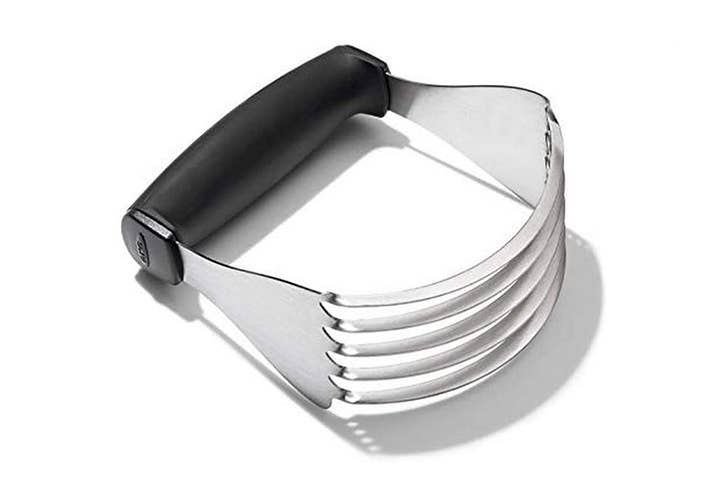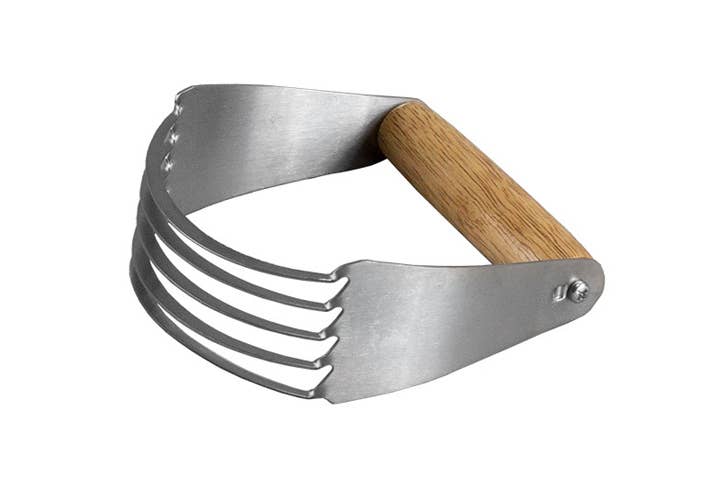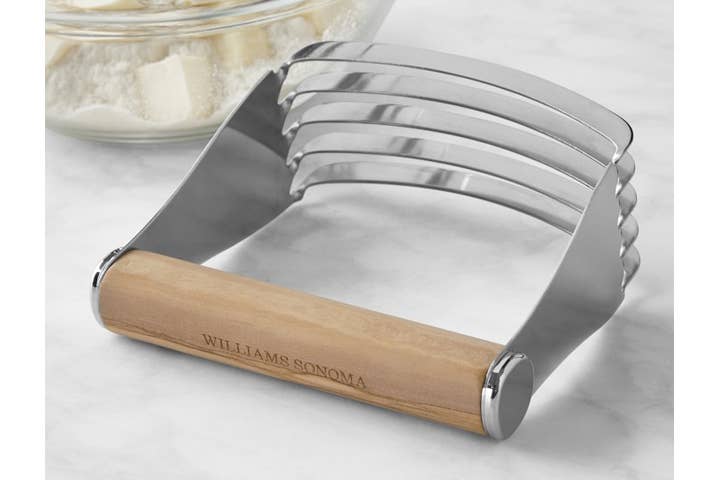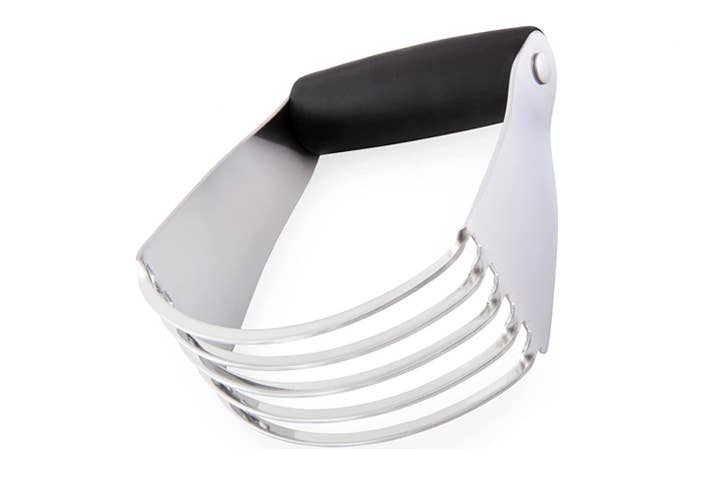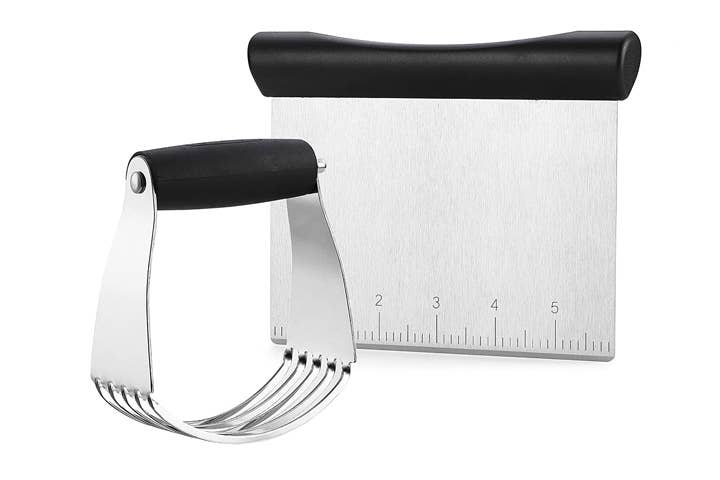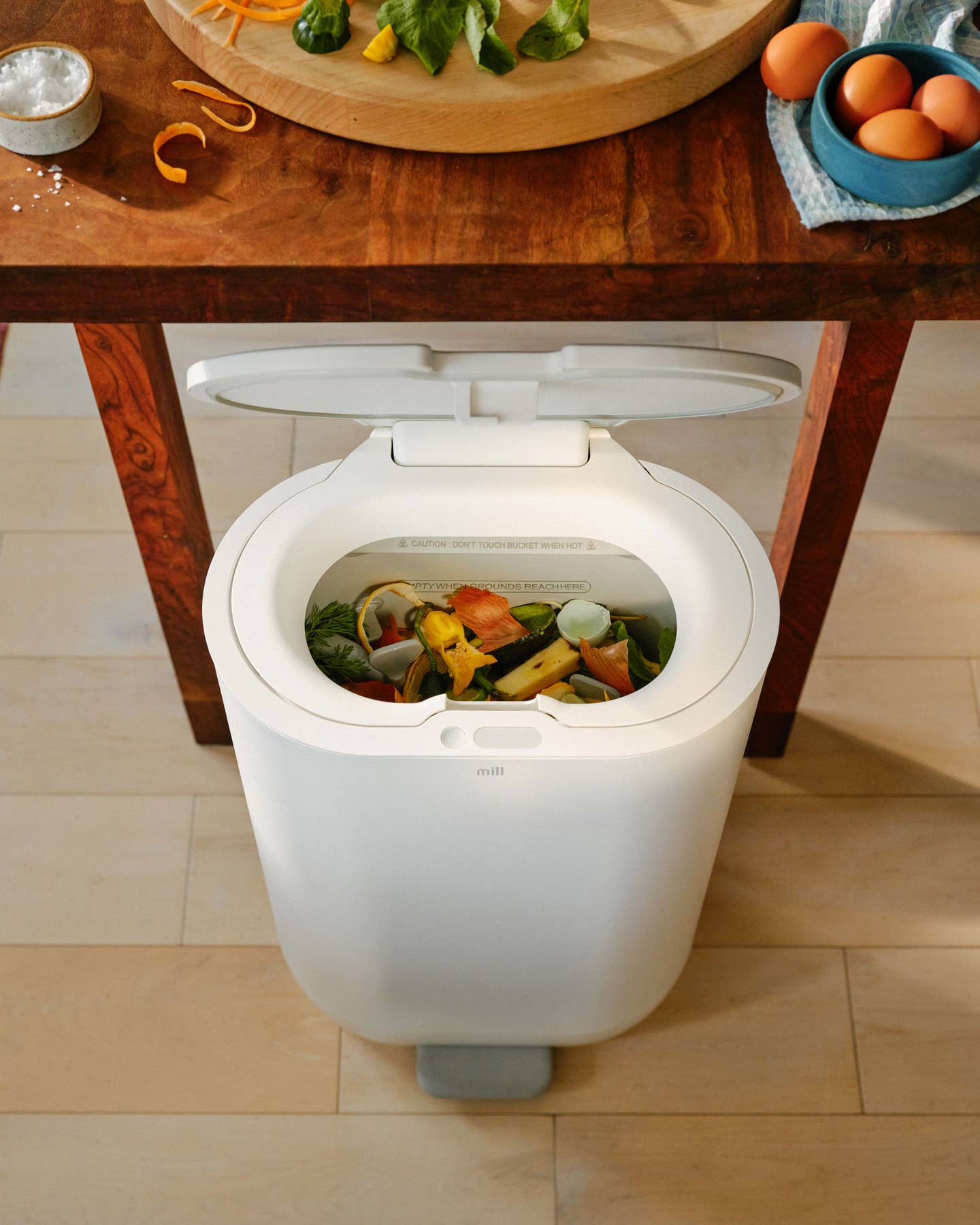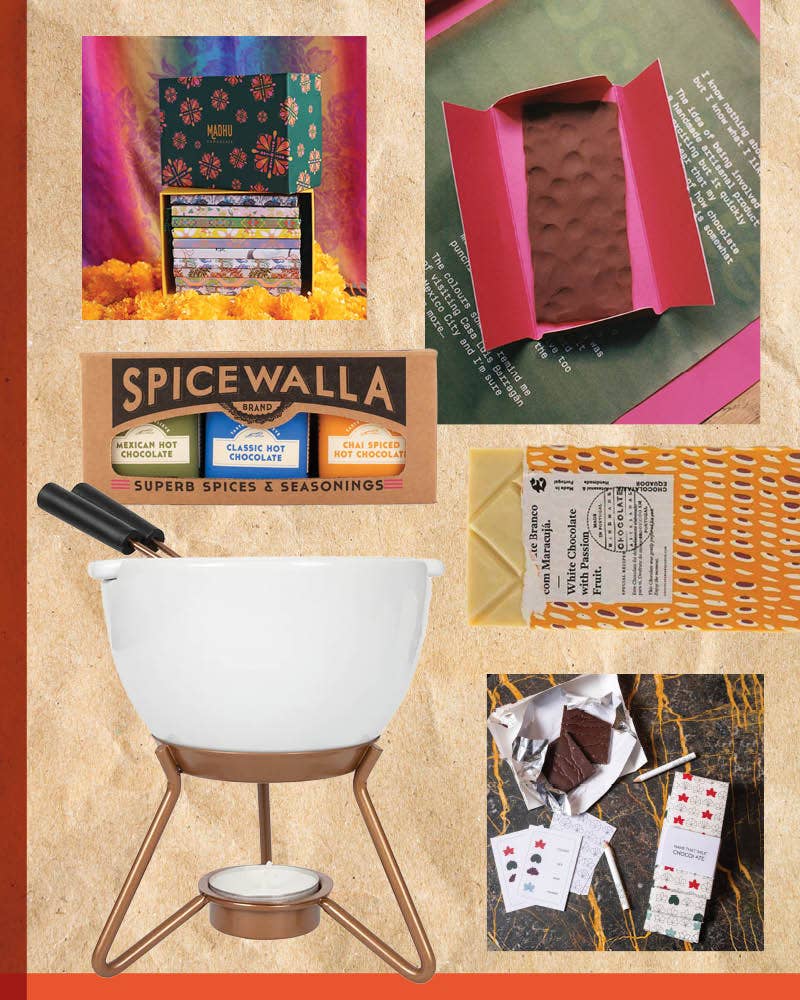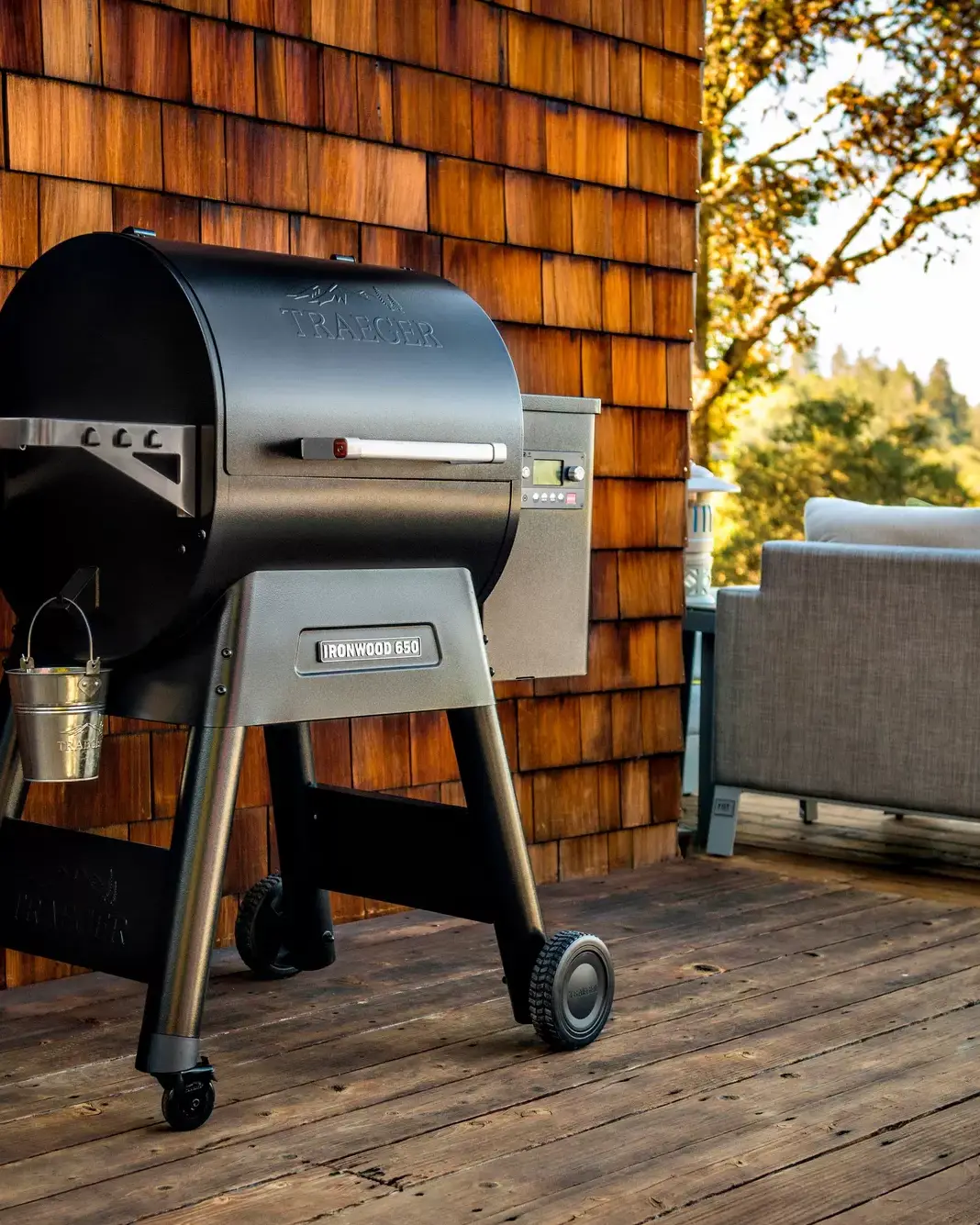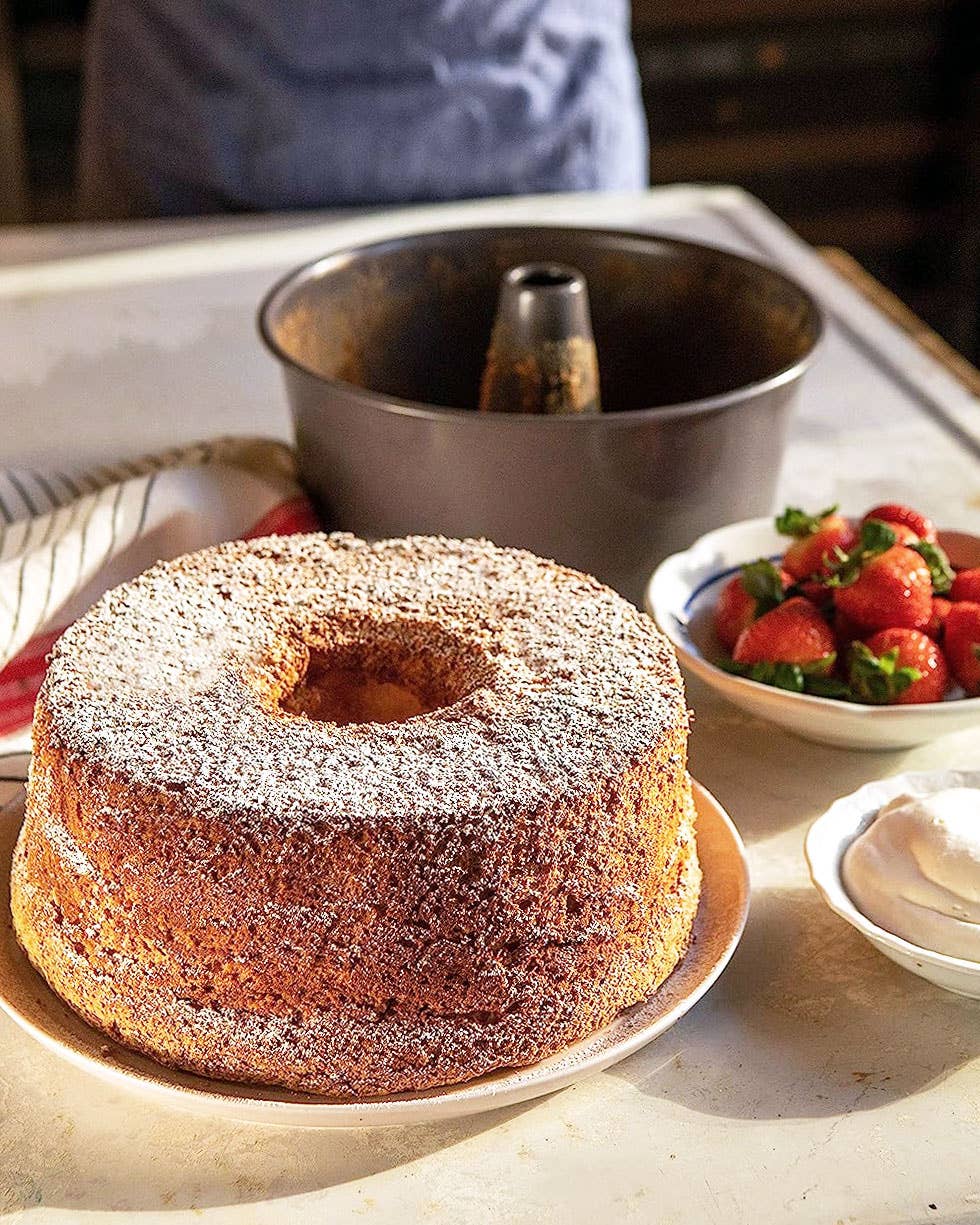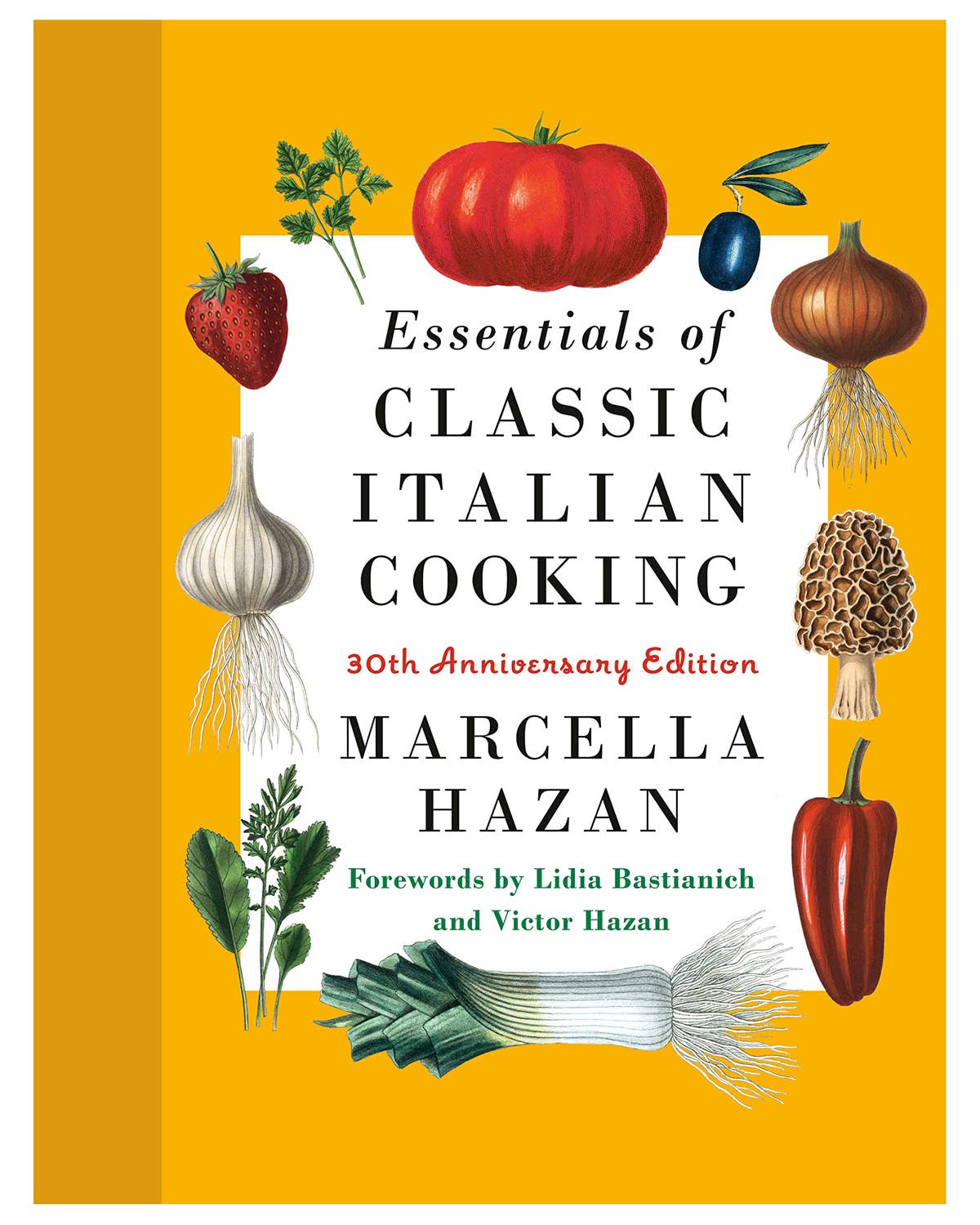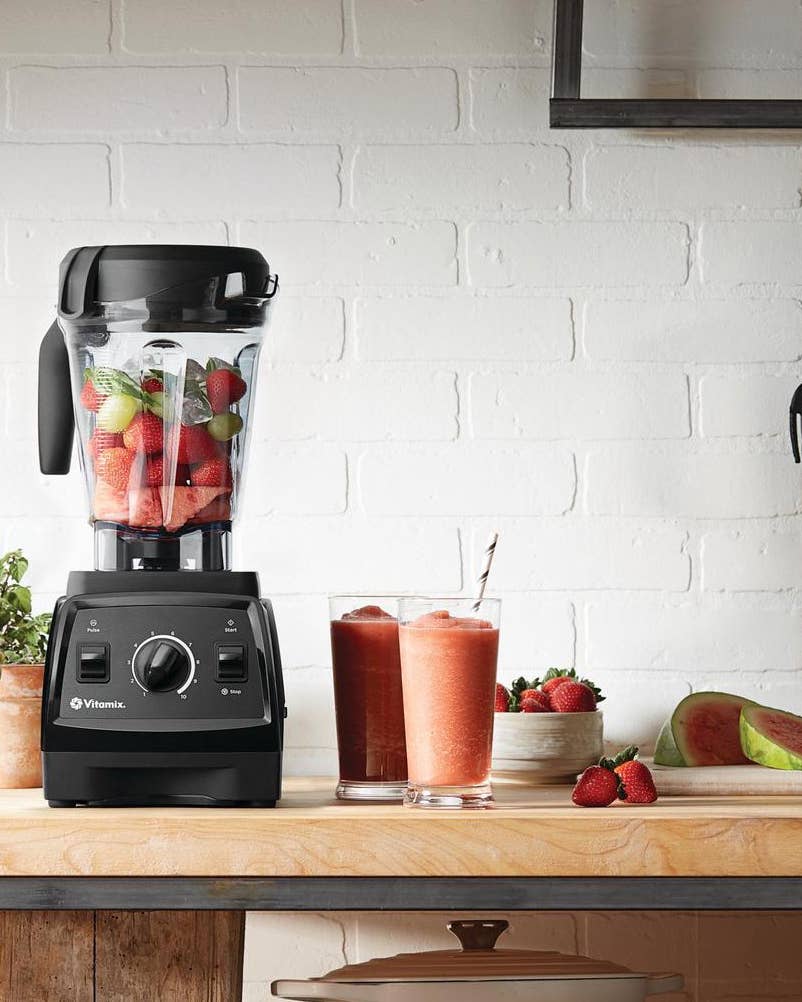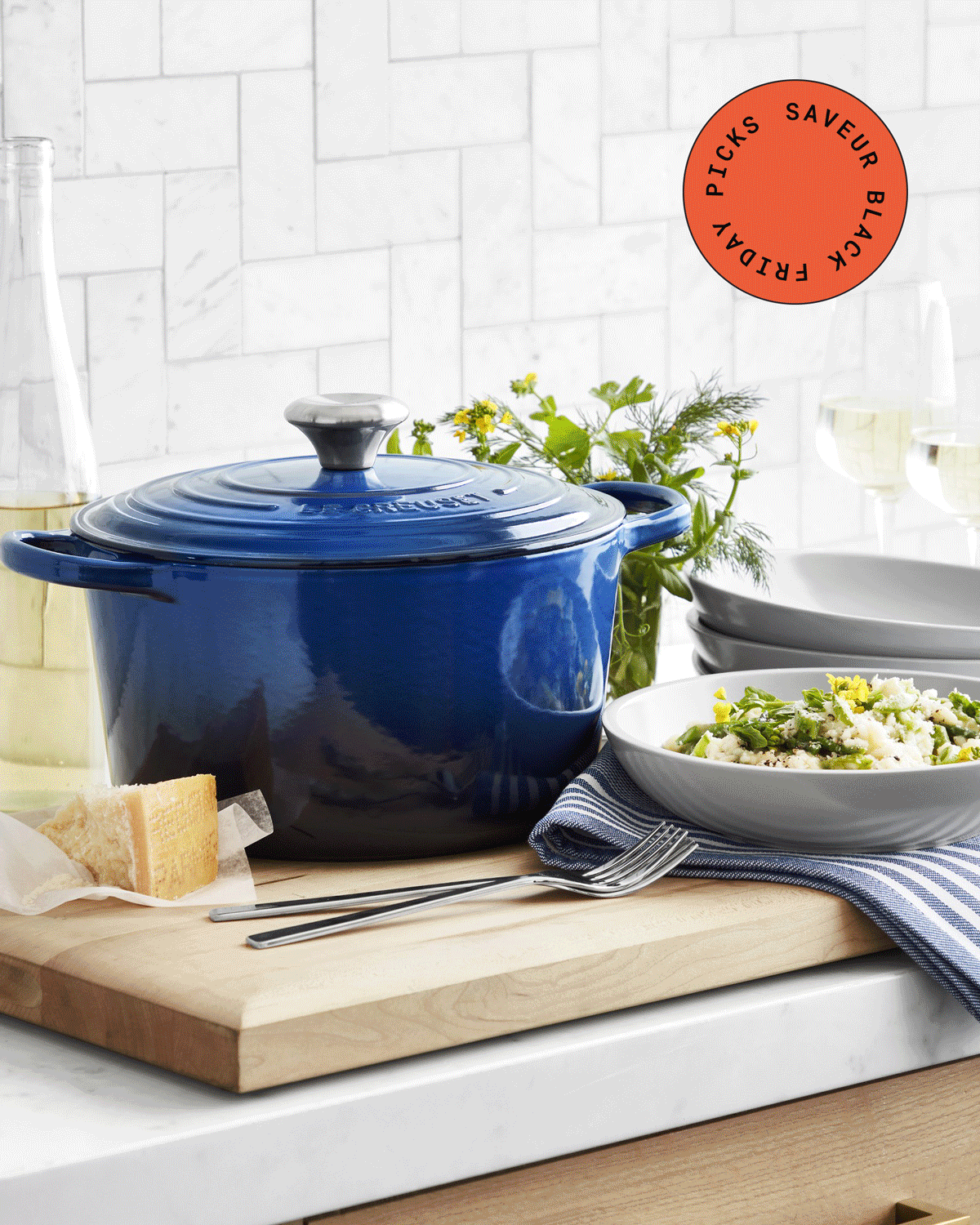The Best Pastry Blenders Make Flaky, Tender Pie Crust Every Time
Unplug your food processor, and pick up your new favorite pastry tool.
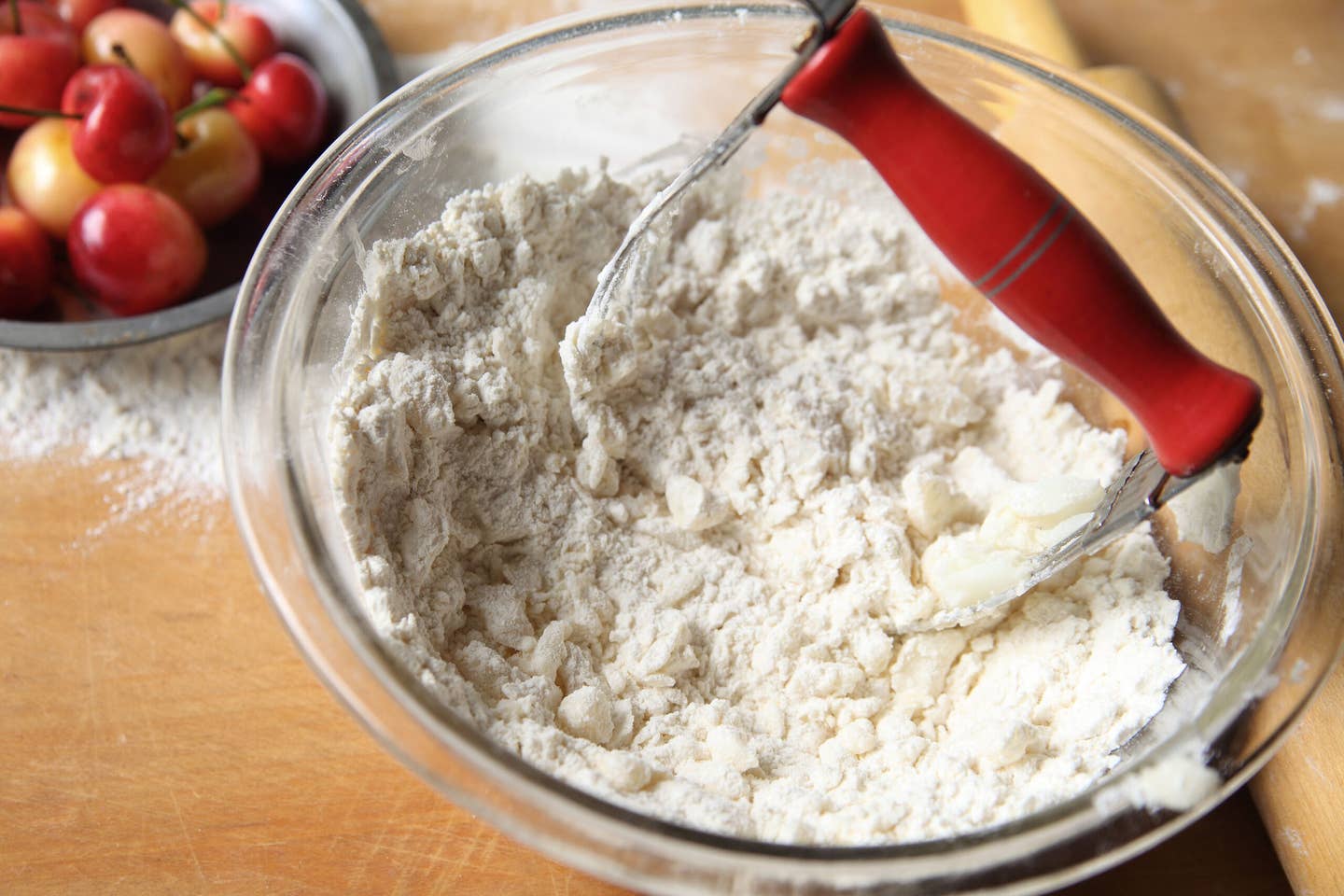
For generations, bakers have been mixing fat into flour to make dough—either with their fingers, food processors, or pastry blenders. Perhaps one of the most humble kitchen tools, the pastry blender makes easy, and even comfortable, work of mixing cold butter, shortening, or lard into flour to make a beautifully flaky dough.
“Making pastries can be tricky!” says Nicole Patel, owner and chocolatier at Delysia Chocolatier. “Ever wondered how to create a perfectly flaky crust or beautifully fluffy biscuits? A pastry blender is the answer! For years, I would mix the butter and flour mixture together by hand. What a mess it would create, and the pastry dough would be tough in the end. A pastry blender ensures that the butter doesn’t become a melted mess in your hands when attempting to blend it with the flour.” Knowing that a food processor, blender, or even the best stand mixers won’t do the job as well as this pie tool can, we set out to find the best pastry blenders to help you craft irresistibly tender pastries at home.
Our Top Picks
- Best Overall: OXO Good Grips Dough Blender and Cutter
- Best Budget: Lodge Pastry Blender
- Most Durable: Williams Sonoma Olivewood Pastry Blender
- Best Grip: Gorilla Grip Pastry Dough Blender & Butter Cutter
- Best Set: Spring Chef Dough Blender & Pastry Cutter Set
Best Overall: OXO Good Grips Dough Blender and Cutter
Best Overall
Material: stainless steel | Weight: 0.15 pounds | Dishwasher Safe: yes
Pros
- Comfortable handle
- Easy to clean
- Can be utilized for more than just combining butter and flour
- Sturdy
Cons
- Handle can be too large for some
- Handle is known to break after a few years
Why we chose it: This pastry blender is well-loved for how comfortable it is to use and how well it holds up compared to other pastry cutters on the market.
Whether you make pastry at home every day or every so often, this dough blender will make the job much easier. The soft handle is not only non-slip, but it will also help keep some of the pressure off your hand while cutting butter into flour. Plus, it’s dishwasher safe, which makes it super easy come clean-up time.
What’s great about this tool, too, is that it can be utilized for more than just biscuit and pie doughs. Patel uses it for oil-based doughs and making her chocolates. “I use this exact pastry blender at home when I make chapatis (Indian flat bread) when I cook traditional North Indian meals,” she says. “Though chapatis don’t contain butter, I love using a pastry blender to mix the oil, flour, and salt to create the dough. At Delysia Chocolatier’s Culinary Center, this tool is primarily used when I create our gianduja, blending the roasted nuts and handmade marzipan with the layers of chocolate. Very similar to the butter and flour mixture, we don’t want the milk fat in the chocolate to separate in the warmth of our hands when mixing with the chocolate, so the pastry blender is the perfect tool.”
And better yet, this is one of the best pastry blenders because it tends to last and is altogether sturdy, which can be hard to come by. Some buyers have mentioned that the handle is liable to break after years of having pressure put on it, though. However, this is not entirely unusual for pastry cutters. Others have also mentioned that the handle can be a bit too big for some users.
Best Budget: Lodge Pastry Blender
Best Budget
Material: wooden handle, stainless steel blades | Weight: 0.19 pounds | Dishwasher Safe: no
Pros
- Affordable
- Durable
Cons
- Hand-wash only
Why we chose it: For less than $10, this pastry blender is incredibly economical with sturdy blades for cutting up cold butter into flour.
“This pastry blender from Lodge Cast Iron is my favorite!” says April Franqueza, pastry chef at High Hampton. “Like everything they make, it’s a workhorse, but the wooden handle makes it pretty enough for me to leave out on my countertop during the summer when I’m making a lot of pie dough for fruit pies. The stainless steel blades will never rust; the only con is that the wooden handle makes it hand wash only.”
There are quite a few low-cost pastry cutters on the market, though many of them run into issues with being flimsy. But the Lodge version is one of the best budget options for the fact that it has very quality, sturdy blades that don’t bend out of place.
Like, Franqueza said, the only downside is that this pastry blender needs to be hand-washed, so just make sure to watch your fingers when cleaning the blades.
Most Durable: Williams Sonoma Olivewood Pastry Blender
Most Durable
Material: olivewood handle, stainless steel blades | Weight: 0.5 pounds | Dishwasher Safe: no
Pros
- Sturdy
- High quality
- Lasts for years
Cons
- Hand wash only
- Pricey
Why we chose it: With a stunning wooden handle, this Williams Sonoma pastry blender is the kind of kitchen tool you may well pass on to future generations.
Although on the pricey side for a pastry blender, this one will give you your money’s worth. It’s well-made and built to last, with an olivewood handle that will add some style to the mix. “I personally love the Williams Sonoma Olivewood Pastry Blender,” says Cambrea Gordon, the pastry chef behind Cambrea Bakes. “It's really great quality, and I've had it for years.”
It’s truly hard to come by a pastry blender that can stand up to the test of time, but this version can. Like the Lodge pastry cutter, though, this one is also hand-wash only.
Best Grip
Material: rubber handle, stainless steel blades | Weight: 5.3 ounces | Dishwasher Safe: yes
Pros
- Thick, comfortable handle
- Affordable
- Comes in multiple sizes
Cons
- Runs small
Why we chose it: With sharp blades and a comfortable handle, the Gorilla Grip dough blender is efficient and easy on your hands.
“I love using the Gorilla Grip Pastry Dough Blender and Butter Cutter because of the thick, sharp blades and handle,” says Romain Cornu, global corporate pastry chef of Tao Group Hospitality. One of the best pastry blenders for grip, the Gorilla Grip has a comfortable, non-slip rubber handle to help you power through cold butter, shortening, or lard. It also comes in multiple sizes, so you can get the one that fits best in your hand. And better yet, it’s less than $10!
When it comes to the sizing, though, this pastry cutter comes in medium and large on Amazon, but many who ordered the medium remarked that theirs seemed small; we recommend ordering the large.
Best Set
Material: stainless steel | Weight: 12.6 ounces | Dishwasher Safe: yes
Pros
- Heavy duty
- Affordable
- Both items can go beyond working with dough
Cons
- Not expressly stated as hand-wash-only or dishwasher-safe
- Dough blender handle is too small for some
Why we chose it: A recommendation from one of our experts, Spring Chef makes hardy, affordable pastry blenders, and for around $10, you can get a quality dough blender and a pastry cutter.
While Cornu likes the Gorilla Grip for its comfortable handle and sharp blades, he likes Spring Chef because of how heavy duty it is. This pastry blender is also sharp (so watch your fingers!), sturdy, and is likely to last you. The pastry cutter that comes in the set is also sharp and great for slicing into dough. But both items can go well beyond the bounds of just pastry. The pastry blender can be utilized to mash bananas or avocados, and the pastry cutter can be used for transferring minced veggies to a bowl or pan or moving hot cookies to a cooling rack.
That being said, some buyers have found the handle on the dough blender to be too small for their hands. As well, Spring Chef doesn’t expressly state if the pastry cutter and dough blender are dishwasher safe. They appear to hold up in the dishwasher, but this lack of guidance does make it hard to properly care for your set.
Things to Consider Before Buying a Pastry Blender
Quality
“Quality should always be at the top of your mind,” Gordon says. “Going for a cheaper blender that has really flexible blades is not going to be strong enough to last very long.” You’ll want to make sure the blades are sturdy, as well as the handle, so that you don’t accidentally get hurt from the blades flipping around onto your hand or the handle coming loose. If you’re shopping in person, Gordon recommends moving the blades back and forth to make sure they won’t flex when you’re using it.
Grip
“Comfort is the most important factor to consider,” Patel says. Generally, you’ll want to go for a handle that has some cushion and is durable enough to withstand a lot of pressure being applied to it. Plus, you’ll want to look out for a straight handle, Gordon says. “Any blender that has a straight and not curved handle is going to be more comfortable to use, especially when you need it to cut straight down into your bowl.”
Cost
Pastry blenders are typically a pretty inexpensive baking utensil, so while you might want to pay a little more for a particularly durable one, Caroline Schiff, executive pastry chef at Gage & Tollner, recommends not going crazy. “It's such a simple piece of equipment, and spending lots isn't necessary,” she says. When it comes to cost, you’ll largely want to consider how often you plan to use this tool and how durable you need it to be, and then decide your optimal price point from there. That being said, you can get a good one for less than $20, so there’s really no need to go over that amount.
FAQs
Is a pastry blender the same as a pastry cutter?
Yes, though pastry cutters can also refer to bench scrapers and wheel pastry cutters.
How do you clean a pastry blender?
Many of them are dishwasher safe, so sticking them in the dishwasher is the easiest way to clean them. However, if yours is hand-wash-only, try soaking it in hot, soapy water, then rinse it clean, gently scrubbing any excess pastry off the blades with a scrubbing sponge. If hand-washing, be very careful with your fingers and hands around the blades so you don’t accidentally cut yourself.
Is a pastry blender better than a food processor for making pastry?
Overwhelmingly yes, according to our experts. “Personally, I do not like food processors for pastries,” says Patel. “It can overwork the dough, and I lose control over the delicate blending of the butter with the flour. The warmth of the motor running in the food processor can also heat up the butter some and break down the milk fat. Plus, food processors are also so bulky and harder to clean. All around, a pastry blender is a more effective and efficient tool.”
Final Thoughts
When it comes to pastry blenders, they’re intended to make what can be an arduous task easier, so pick one that has a comfortable grip, sturdy blades, and a price point that delivers decent quality without going overboard.
Methodology
Many pastry blenders look pretty similar and perform very similar functions—and most of them cost less than $20. So when deciding which pastry blenders to include on this list, we took to the experts, asking pastry chefs and baking influencers for their pastry cutters of choice. We also looked at durability, how comfortable the grip is, the ease with which it cuts, and how easy it is to clean. With all of this in mind, we made our top selections.
Keep Reading
Continue to Next Story
